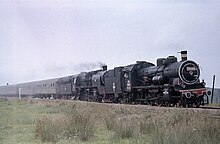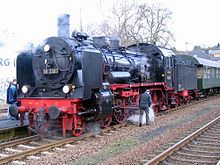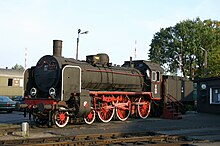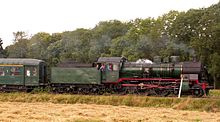Prussian P 8
| Prussian P 8 DR series 38 10–40 CFR series 230 ÖBB series 638 PKP series Ok 1 SNCF 230 C / E / F / H DSB series T SEK series Ζδ LG series K8 NMBS / SNCB series 64 |
|
|---|---|
|
Prussian P 8 in Länderbahn livery
|
|
| Number: | 3946 |
| Manufacturer: | AEG , BMAG , Borsig , Hanomag , Henschel , Hohenzollern , Humboldt , Maschinenbau-Gesellschaft Karlsruhe , Linke-Hoffmann , Schichau , Union , Vulcan , Wolf |
| Year of construction (s): | 1906-1930 |
| Retirement: | 1972 (DR) 1974 ( DB ) |
| Type : | 2'C h2 |
| Genre : | P 35.17 |
| Gauge : | 1435 mm ( standard gauge ) |
| Length over buffers: | 18,585 mm |
| Height: | 4,550 mm |
| Wheelbase with tender: | 15,565 mm |
| Smallest bef. Radius: | 140 m |
| Empty mass: | 70.70 t |
| Service mass: | 78.2 t |
| Service mass with tender: | 129.7 t (with tender 2'2 'T 21.5 (pr) and full stocks) |
| Friction mass: | 51.60 t |
| Wheel set mass : | max 17.7 t |
| Top speed: | 100 km / h (forward) 50 km / h (backward) 85 km / h (backward with closed cab and tub tender) |
| Indexed performance : | 868 kW / 1180 PSi |
| Starting tractive effort: | ~ 113 kN |
| Driving wheel diameter: | 1,750 mm |
| Impeller diameter front: | 1,000 mm |
| Control type : | Heusinger |
| Cylinder diameter: | 575 mm |
| Piston stroke: | 630 mm |
| Boiler overpressure: | 12 bar |
| Number of heating pipes: | 119 |
| Number of smoke tubes: | 26th |
| Heating pipe length: | 4,700 mm |
| Grate area: | 2.58 m² |
| Radiant heating surface: | 14.47 m² |
| Tubular heating surface: | 128.81 m³ |
| Superheater area : | 58.90 m² |
| Evaporation heating surface: | 143.28 m² |
| Brake: | Automatic single-chamber compressed air brake type Knorr, acting on both sides of the coupling wheels, from year of construction 1913 also bogie wheels braked |
| Train heating: | steam |
The passenger train - steam locomotive of type P 8 of the Prussian State Railways , on the Deutsche Reichsbahn class 38 10-40 , was designed in 1906 by Berliner Maschinenbau AG (formerly Louis Schwartzkopff ) according to the specifications of the Prussian locomotive department head Robert Garbe . It was intended to be the successor to the P 6 .
construction
Since Garbe was an advocate of the simplest possible designs, a superheated steam twin engine was provided for the P 8 . The P 8 benefited in particular from the superheated steam technology just developed by Wilhelm Schmidt , which led to outstanding performance for the time. The P 8 was a very economical locomotive that made no great demands on the skills of the train driver . Garbe initially even planned the P 8 as an express locomotive with the expectation of reaching a top speed of 110 km / h . For this, the first examples were equipped with streamlined, tapered cabs .
The successful overall construction initially had a few weak points. So the very vaporizing boiler (this already had an indicated combustion chamber at the front end of the fire box ) faced some teething troubles, e.g. B. the under- dimensioned espagnolette bearings, which constantly tended to overheat , or the inadequately tightly coupled Prussian box tender, which led to frightening running characteristics when reversing. The running properties in particular were never entirely satisfactory. Due to the poor mass balance , the maximum speed estimated by Robert Garbe could never be reached. This was ultimately set at 100 km / h.
Characteristic of the P 8 is the greater distance between the central and rear coupling axles . At the beginning the P 8 only had a steam dome behind the sandpit, later a front dining dome was added; But there was also the arrangement with a steam dome in front of the sandpit, or with two sandboxes. Other structural changes included a. the cab roofs, the smoke deflectors , the superstructures. The controls of the first locomotives had hanging iron , but the majority had a Kuhn loop .
Changes during the construction period concerned the installation of a feed water preheater , a sludge separator and a conical chimney, which was later given an attachment.
In order to be able to turn the locomotive on small turntables , the Prussian State Railroad equipped the P 8 with tenders, which originally held 21.5 cubic meters of water and 7 tons of coal. From 1950 the Deutsche Bundesbahn coupled the class 38 with tenders of decommissioned war locomotives , especially with tub tenders , which could hold more operating materials. With locomotives, which also received a cab rear wall, the maximum speed could be increased from 50 km / h to 85 km / h when reversing.
The Deutsche Reichsbahn used some of the tenders from decommissioned class 17 steam locomotives , so-called long-distance tenders . 75 locomotives were also equipped with a Giesl ejector , recognizable by the elongated chimney.
Performance
In two official works there are performance tables for the P 8, both of which were published during the construction period and contain different information. On the one hand the “Merkbuch for the vehicles of the Prussian-Hessian State Railway Administration” from 1915 and on the other hand the “Merkbuch for the vehicles of the Reichsbahn. I. Steam locomotives and tenders (standard gauge) ”from 1924. The first panel only shows data up to a V max of 90 km / h, the second up to 100 km / h. For example, in 1915 loads of 455 t at 90 km / h and 1800 t at 40 km / h are given for the plain. For 100 km / h in 1924 a capacity of 300 t tensile load is listed, whereas at 90 km / h 540 t were permissible, and no information is given for 40 km / h. At a gradient of 10 per mille and 70 km / h, the value in both tables is 155 t, but at 40 km / h they differ again: In 1915 the limit was 330 t and in 1924 forty tonnes more.
history

The order to build the first ten machines was given to Berliner Maschinenbau AG, formerly L. Schwartzkopff, in January 1906. The first machine of this type was put into service under the name "Coeln 2401". The test drives with up to 14 express train cars on the hook between Güsten and Sangerhausen were successful.
From 1906 up to and including 1918, P 8s were produced in 1887 for the German state railways and the military railroad directorates in Brussels and Warsaw. From 1919 to 1923 a further 1,669 machines were added, making a total of 3556 units for German administrations.
After the end of the Second World War, 1253 locomotives were counted in the German western zones in 1945, and around 700 in the Soviet-occupied zone. The series was highly valued due to its solid construction and economical consumption, and locomotives that had been parked for years were refurbished.
From 1954, 41 locomotives were converted by the DB for use with push-pull trains . In addition to a class 52 tub tender, they also received their locomotive tender coupling and closed driver's cabs, the second axle also received sand downpipes on both sides, for which most locomotives got a second sand container on the boiler. The remote control device, which transferred the instructions from the control car to the engineer's cab, came from Fabeg and Hagenuk . The push-pull train operation ended in April 1965.
The P 8 was very versatile. Except for the heavy express and freight train service, it was used in almost every train. The railroad administrations could not do without these machines for a very long time, because the last P 8s were retired from the Deutsche Reichsbahn in 1972 and from the Deutsche Bundesbahn in 1974. From the 1960s onwards, they became increasingly superfluous and decommissioned due to increasing route electrification and dieselization. More than 500 P 8s have served more than 50 years. At the DB, the locomotives were run as the 038 series from 1968 onwards, but the first digit of the serial number was omitted, and adjacent unused numbers were selected in the event of overlaps. From 1970 onwards, the DR number only added the control number.
Most of the P 8s were built by Berliner Maschinenbau AG with 1,025 units, followed by Henschel & Sohn in Cassel with 742 units. In addition to the Prussian State Railways, the Grand Ducal Oldenburg State Railways also bought five machines. With the exception of the locomotive builders Hartmann and Esslingen, all German locomotive factories later supplied P 8 locomotives.
P 8 at the Baden State Railway
In order to compensate for the lack of locomotives that arose after the First World War due to armistice taxes and a high number of harmful locomotives, the Karlsruhe directorate had 40 P 8 machines built by the mechanical engineering company in Karlsruhe . They were stationed in Villingen, Mannheim and Karlsruhe. They were given the train numbers 1153 to 1192. In 1925, they were classified as 38 3793 to 38 3832 on the Deutsche Reichsbahn.
P 8 on the Mecklenburg Friedrich-Franz Railway
The P 4.2 procured for operation on the route to Warnemünde were soon no longer able to cope with the increasing demands. From 1914 to 1916 , the Friedrich-Franz-Eisenbahn procured 10 locomotives from the Humboldt mechanical engineering company . In 1917 three brand new locomotives were taken over from the Prussian State Railways. The machines were given the track numbers 251 to 263. After the locomotives with the numbers 258 to 260 had to be handed over to Belgium as reparations in 1920 (B 6400, B 6401, B 6431), the state railway received three machines made by Henschel in 1922 as replacements. The track numbers 264 to 266 were assigned to them. The Deutsche Reichsbahn redrawn all locomotives in 1925. The machines were given the numbers 38 1573–1575, 1750, 1751, 1791, 1792, 2023, 2026, 2119, 3674–3676.
P 8 in other countries
In the course of the ceasefire levies and territorial assignments, 627 copies had to be handed over to the victorious powers after the end of the First World War. Poland received 192 and the PKP listed it as Ok 1 . In Belgium , the 168 machines were referred to as the 64 series at NMBS / SNCB . After France came 1919 162 locomotives, of which 25 to the AL , 25 to the EST , 75 at the NORD , 17 in the ETAT (retired as 230,943 to 959, except for the 943 all in 1940) and 20 to the MIDI went. In 1945 four more machines came to the SNCF as spoils of war . Lithuania received 11 pieces and named them K8 . 41 machines remained with the Saarbahnen , 25 units were sent to Italy as the 675 series , Romania received 18 units and ten P 8s found a new home in Greece as the SEK series Ζδ .
By 1923, the newly founded DR replenished the P 8 with new buildings. The state railways of Poland , Romania and Lithuania also procured additional, brand-new P 8. Hanomag, Linke-Hoffmann and BMAG built a total of 65 machines for the PKP, which were given the company numbers Ok1-201 to 265. The companies Hanomag, Henschel and again BMAG built 75 units for Romania in 1921, another 18 units were sold by the Deutsche Reichsbahn in 1926, and in 1930 Henschel and BMAG delivered another 20 machines to CFR . In 1932 the licensed replica of the P 8 began in the two local locomotive works in Malaxa (91 pieces) and Reșița (139 pieces). The series designation CFR 230 applied to all machines, regardless of the production location. Lithuania received a total of five K8s, which were delivered by BMAG in 1925. A total of 3946 copies of the P 8 (including the replicas in Romania) were built, making it one of the world's most popular passenger locomotives.
Between 1923 and 1928, 190 machines of the PKP Ok22 series were delivered to Poland by Hanomag . This series was based with minor deviations on the design of the German P 8, the most striking outwardly was the higher boiler.
The P 8 was already in use in Austria in the interwar period , and around 1930 the BBÖ used several copies borrowed from the Deutsche Reichsbahn, which even covered the Orient Express between Salzburg and Vienna as a representative . After the Second World War , 38 1069, 1391, 1434, 1677, 1809, 1818, 2052, 2692, 3264, 3495 and 3525 remained in Austria. The 38 2052 was returned to the Deutsche Bundesbahn in 1952 . The 38 1391, 1434, 1818, 3495 and 3525 went to the Soviet Union . The remaining five machines formed the ÖBB series 638 . In 2004, the ÖGEG acquired two machines of this type from Romania (replica), one of which with the fictitious number ÖBB 638.1301 carries out special trips.
After the Second World War, three damaged locomotives, 38 2126, 2625 and 2877, remained in Denmark , which were purchased and refurbished by Danske Statsbaner . They were used in Jutland as the T series until 1956 .
In Bulgaria , Yugoslavia , the Netherlands and Czechoslovakia , further P 8s were found after the chaos of war.
Preserved locomotives

- One of the preserved P 8s is 38 1182 , which belongs to the DB Museum Nuremberg . It was built by Schwartzkopff in Berlin in 1910 and was in operation for 61 years. After a trip to Gera it is back in the Arnstadt depot .
- The last P 8 of the Deutsche Bundesbahn has been in the locomotive shed at the Hanau depot since June 2015 . Officially parked on December 5, 1974, 38 1772 (provided with the computer number 038 772-0 since 1968) was still in use for farewell trips until February 13, 1975. It was last used at the Rottweil depot, where the last 78 series was also used as planned. Built in 1915 by F. Schichau in Elbing , it covered 3,719,271 kilometers before it was retired. In the 1980s she was reactivated for special trips by railroad enthusiasts and had an accident on the Sauschwänzlebahn , whereby the original tender was destroyed. Since it had to be parked in 1993, 38 1772 has been preserved as a rollable monument.
- In PKP -Bw Wolsztyn Ok 1-359, the former is 38 in 2155 obtained but operable as cold exhibit and thus do not. A work-up is not planned.
- The Bochum Railway Museum owns the operational 38 2267 (built in 1918), which is used in front of nostalgic RuhrtalBahn trains in the Ruhr area and for special trips by the museum.
- In the German Steam Locomotive Museum (DDM) in New Market is located since 1977 38 2383 . It was built by Henschel in 1919 and was the penultimate P8 of the Deutsche Bundesbahn .
- Another former Prussian P8 is in the new vehicle hall of the DB Museum Nuremberg , the 38 2884 built by AG Vulcan Stettin in 1921 .
- The 38 3156 operated on the Kaiserslautern – Heilbronn route during the event "20 Years of VRN" . This is the 638.1301 of the ÖGEG, which was renamed for the event.
- The former 38 3192 is also located in the PKP's Wolsztyn depot as Ok 1-322, it was built by LHM (2269/1921).
- The 38 3199 of the South German Railway Museum in Heilbronn has a special fate . It was built in 1921 by the Linke-Hofmann-Werke in Breslau. At the Deutsche Reichsbahn it first had the number 2580 Elberfeld and was then redrawn as 38 3199. She was last stationed at the Bw Breslau . The Romanian CFR bought the machine as early as 1926 . In Romania it received the number 230.106. In 1974 it was shut down. Railway enthusiasts discovered them in the scrap yard and had them refurbished in 1999 in Cluj in the outfit of the early Reichsbahn. Since 2002 the locomotive has been used again for nostalgic trips.
- The 38 3180 was like the 38 3199: built in 1921 at Linke-Hofmann-Werke Aktiengesellschaft ( Breslau ) with serial number 2257. At the Deutsche Reichsbahn it was first numbered 2586 Halle and in 1925 it was renamed 38 3180. It was sold to the Romanian State Railways (CFR) on July 23, 1926 (230.105 there) and, after regular use, served as a “strategic reserve” - parked in Lugoj (Romania). In 1998 the Bavarian Railway Museum was able to acquire the locomotive and have it partially refurbished in the Cluj-Napoca plant . The machine has been in Nördlingen since August 15, 2001 . The locomotive was equipped with a new boiler while it was in service with the CFR in Aw Cluj Napopca.
- In Böblingen-Hulb near Stuttgart is in the parking lot of a shopping mall at 48 ° 41 '12.55 " N , 8 ° 59' 5.2" O to 38 3650 . It was delivered to the (Hamburg-) Harburg depot in 1922 as Elberfeld 3097, was in use there until 1945 and was retired in Tübingen in 1972. Since it was set up outdoors, the locomotive is now quite run down.
- The former 230 111 of the Romanian CFR was reconditioned in the Railway Museum Darmstadt-Kranichstein as 38 3999.
- In the district Berenbostel the city of Garbsen , near Hanover is a 1922 at Hohenzollern -built P 8 with Witte - skirting . Behind the machine with the DB vehicle number 038 711-8 , two old wagons are used as a restaurant.
- Länderbahnreisen / Manuel Jußen is the owner of the P 8 2455 Posen , which was stationed in the Dieringhausen Railway Museum until 2012 and is now based in Gera. The 2455 Posen was built in 1919 by Linke-Hofmann-Werke in Breslau under the serial number 1804. Sold by the DR to Romania in August 1926, it was used there with the number 230 094 until around 1974. After being sold to the current owner in spring 1998, it was rebuilt in Romania in 2001. It is presented as it was in the early 1920s. The locomotive was used in 2007, 2008 and 2009 as a tractor for the “ Train of Remembrance ” and is operational. This machine has been at home in the Augsburg railway park since 2014 .
- The Austrian Society for Railway History (ÖGEG) owns an operational P 8 replica of Romanian production. Road number 638.1301, built in 1935
- The P 8 with the Belgian number 64 169 transferred from Romania to the “Patrimoine Ferroviaire et Tourisme - Toerisme en Spoor Patrimonium” railroad friends' association in Belgium in March 2007 is the Romanian 230 084 , which was manufactured by Henschel with the serial number 18939 .
annotation
As early as the late 1930s, the Reichsbahn was planning to replace the P 8, which was now getting on in years, with a new locomotive. This led to the development of the 23 series with the 1'C1 'wheel arrangement, of which only two prototypes were built in 1941. Because of the Second World War , series production was no longer started.
In 1950, the Deutsche Bundesbahn began to procure the newly developed 23 as a replacement for the P 8. By 1959, 105 units had left the factory. The change in traction meant that the last 23 was retired from DB just one year after the last P 8.
From 1955 to 1959, the Deutsche Reichsbahn procured a locomotive type based on the dimensions of the DR locomotive as the 23 10 in 113 copies.
Varia
In many of his stories, Jochen Kretschmann reports very vividly about the sometimes very tough everyday life in the GDR on the P 8 with inferior coal (brown coal), malnutrition and total exhaustion of the staff.
See also
literature
- Wenzel, Gress: 100 years of the Prussian P 8 . Eisenbahn-Kurier Special 80, EK Verlag, Freiburg 2006
- Karl Julius Harder: The P 8. Development and history of a European steam locomotive . Franckhsche Verlagsbuchhandlung, Stuttgart 1974, ISBN 3-440-04116-6
- Konrad Koschinski: Prussian P 8. Technology, use, museum locomotives . Eisenbahn Journal Spezial 1/2016.
Individual evidence
- ↑ Dr. Günther Scheingraber, Manfred Weisbrod: Prussia Report No. 7. Hot steam passenger locomotives P 6, P 8, P 10 and Prussian tenders . Hermann Merker Verlag GmbH, Fürstenfeldbruck 1993, ISBN 3-922404-53-7 , p. 24-25 .
- ↑ Scheingraber, Weisbrod, 1993. p. 23.
- ↑ Scheingraber, Weisbrod, 1993. p. 32.
- ↑ Peter Schricker: Successful even in old age . In: railway magazine . No. 3 , 2019, ISSN 0342-1902 .
- ↑ Klaus-D. Holzborn, Jürgen Gottwald: Backwards with the driver's cab closed . In: railway magazine . No. 9 , 2015, ISSN 0342-1902 , p. 76-81 .
- ↑ Les services des lokomotives armistice 1918 in: Ferrovissime No. 96, p. 12 ff.
- ↑ Scheingraber, Weisbrod, 1993. p. 35.
- ↑ a b Scheingraber, Weisbrod, 1993. p. 36.
- ^ Herman Gijsbert Hesselink, Norbert Tempel: Eisenbahnen im Baltikum, Münster, 1996, ISBN 3-92198051-8 , p. 68.
- ↑ Konrad Koschinski: Prussian P 8. Technology, use, museum locomotives . Eisenbahn Journal Spezial 1/2016.
- ↑ DSB Litra T steam locomotive T-maskine. Retrieved October 22, 2017 .
- ↑ 38 1772 ( Memento of the original from April 3, 2008 in the Internet Archive ) Info: The archive link was automatically inserted and not yet checked. Please check the original and archive link according to the instructions and then remove this notice.
- ↑ On the history of the steam locomotive 038 711-8
- ↑ http://laenderbahnreisen.blogspot.de/
- ^ Message from the Augsburger Allgemeine from November 12, 2014.
Web links
- Information on the surviving locomotives of the 38.10-40 series on the "Railway Museum Vehicles" website






